Colima-Comala-Colima
Tues. Feb. 20: The next morning, we fly past palms andevergreens and various flowering trees as we traverse the Coastal Highway. Fora while, we can see the Pacific from the road, but after a while, we haveturned away from it. We are on our way to the city of Colima, which is thecapital of the state of Colima. We booked a two-day excursion from Pepé Tours, led by JoséGonzales. He picked us up promptly in a huge white van, which reminded us ofthe vehicle we called "the bread truck" when we were in France. Of course, noone much younger than our gang will remember the bread trucks of old. Just knowthat they are huge. He could fit 14 people in it and we are only five, plusJosé.
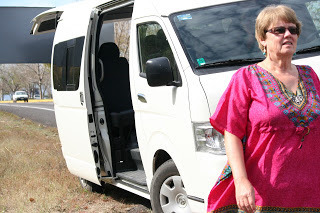
José is a slim, lively man with a great command of Englishand a wicked sense of humour. We took to him at once. As he drives, he talks about the natural gas pipeline thathas been coming into Manzanillo for at least as long as Maire and John havebeen staying here (five years). It's finally ready, simply awaiting thePresident of Mexico to open it on March 21 with a grand flourish andcelebration. The gas will come from the Gulf of Mexico and the line wasconstructed by a Canadian company. The pipeline means a lot to Manzanillo, from cleaner air tomore energy for more projects. There are tons of improvements an expansionsbeing made to the harbour, for instance, which is already the largest in NorthAmerica. I can still picture the development from the vantage point of themountain yesterday. We are driving along a new toll road, which curves aroundthe bay. Palms and evergreens and bushes are lush and partly flowering. Joséexplains that the winter months are kind of like our "autumn"; leaves fall andthe trees are comparatively bare of flowers. Some have begun already, though,such as the primavera. In April, our street in Las Brisas will be covered inred flowers from the "red flame" trees (also known as the Royal Poinciana).Black sand beaches glint in the sun, as we follow the chain of volcanoes thatstretch from Central America to northern Mexico, including Mexico City. Colimais the third largest state in the country. Its main crops are coconuts, limes,sugar, and sea salt. Many of the crops were ruined in the October hurricane,but they're well on their way to recovery now. Colima City is the statecapital, as well as home to the largest Corona plant, yay! Green waving stalks of sugar, flowering coffee bean plants,row upon row of lime and papaya trees decorate our view as we drive along. Afence around one farm of bushy limes is covered in bougainvillea: red, pink andwhite bouquets of color. We stop and look down upon a clay brick operation,family-owned, where the red shapes are formed by hand. A huge oven cooks theminto rounded half cylinders for rooftops. José says they get about half a pesoper brick, despite the hours of work that goes into them. We cross the ArmeriaRiver, peer down from the winding highway at lagoons and trees, tiny shackswith laundry hanging in the sun. Cows resting amid tall palm trees. Sugar cane,which is now harvested by machine, wave long hairy green arms. Cement is a bigindustry in this part of the state, with its soft limestone mountainsides.These are part of the Sierra Madres, gorgeous undulating mountains of green. Yaka is another popular fruit. We pass dozens of standsselling everything, all appearing succulent and delicious in the freshness ofthe day. As we get closer to Colima, watermelon and cantelope are also onoffer. We know how sweet these are from first hand experience. Agava plants dotthe roadsides – ahh, tequila! The primavera trees are beginning to flower, their blossomsa deep yellow or pink in the sunlight against an azure blue sky. Cacti strike astraight backed pose along the folds of the hillsides. Now we can see the twin volcanoes of Colima shimmering inthe distance. Here's a tourist guide's description from our favorite Internetsite (www.gomanzanillo.com): Driving north from Manzanillo, tourists willalways remember their first view of the majestic mountains of Colima. The inactive,snow-capped Nevado de Colima, towering above 14,200 feet and its activesmoke-and lava-spewing partner, Volcan de Colima, at more than 13,488 feetoverlook a lush, forested valley and tranquil lake. Lake Maria is formed byanother extinct volcanic crater, and is said to be 2,000 ft. deep. We stop andVince snaps some fantastic photos. One of them shows a cloud that resembles anenormous iguana. Ben's gila monster in cloud formation!
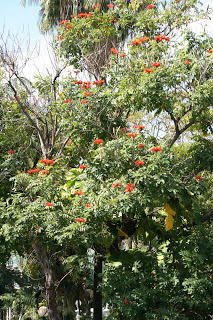
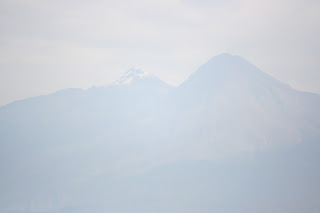 You have to look closely through the haze to see the twins!
You have to look closely through the haze to see the twins!Colima and its twin city of Alvarez hold nearly 250,000people. The natives were the Aztecs, the last chief being Coliman, thus thename of this beautiful place. Colimotes means "place of my grandfather". Theenormous sculpture of the hairless dancing dogs (Perros de Colima Bailarines)greets us at the outskirts. José says they herald good times and I am smittenwith the idea. The Shaman of the Aztecs would use them as symbols (andsacrifices) to ask the gods for joyful times. One of the dogs gives a "Tony"smile, just like my sister Chris's dog.
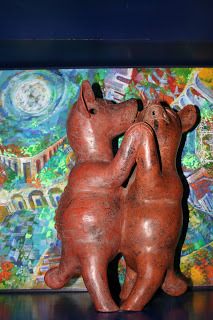
We stop in the square where the Ave Maria church, thegovernment building, stores and restaurants, plus our hotel, surround a lushJardin. The church is partially constructed of volcanic rock and topped withone enormous cupola and cross, and another smaller one. Our hotel is a Best Western,the Ceballos Hotel, once owned by a family of that name. Its ornate balconieslook out over the Jardin and the square. We check in, where we discover that wehave two rooms side by side, with a lovely sitting room in between. All alongare the Romeo and Juliet style balconies.
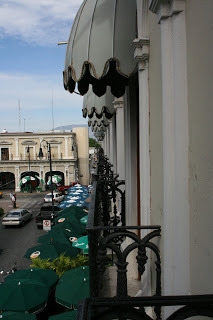
The parade of horses has been postponed to tomorrow, so wedecide to go to Comala today instead. As we head toward the smaller village, wepass an arena where cock fights still take place. People bet on the rooster oftheir choice. Once the bets are in, the doors are closed and no one can leaveuntil everyone declares they are satisfied with the outcome. It is a fight tothe death. I try not to picture the blood and feathers or to imagine the smellof such violence. The town of Comala is known as Pueblo Blanco, the whitecity, as it is renowned for everyhouse being covered in sparkling white paint. The streets are cobblestone,which makes for a very bumpy ride as we traverse the narrow roadways. We passcoffee plants, sporting white flowers, and here and there, a red bean signifiesit's ready to be picked. Old wooden doors or grayish plaster walls hide thelovely little courtyards within. José points out a door that harks from the 17thCentury. He says that no one really cares about the front of the houses; it'sthe courtyard and home that count. Comala is famous for a special coffee drink,which we hope to try. It's also lush with the parota, an exotic hardwood tree,which is used for furniture, doors, cabinets, and even ceilings. It's easilycarved and sanded into ornate decorations and shapes. We stop for lunch at Don Camalon. We've been here before, sowe know what to expect, but it's still an astonishing bounty. We are served atleast eight dishes before we say, "No mas". The food comes with the beer and isenough to make all six of us feel absolutely stuffed. José calls John acomelon, which means "good eater" because he is able to put away more than therest of us. Afterward we set off for Nogueras, the site of an art museum,Centro Cultural Nogueras-Museo "Alejandro Rangel Hidalgo". The buildings andgrounds used to be a hacienda, some parts of which are over 450 years old. Thechimney from the 17th Century sugar mill stands half crumbled abovethe rooftop of the old church and buildings. José points out the tamarinds andtells us the fruit from this tree makes a sweet sauce. Later, we find out thathe is absolutely right. The hacienda shape is still evident. The master's housestands at the top of a square horseshoe, behind which were gardens, the mill,and fields of whatever crop they grew. In front, forming the sides of the shoe,a church and stores. Further on, the workers' homes. José recounts how themasters owned the only grocery store, so the workers would shop on credit.Since they never made enough to pay it back, they were always in debt. St.Peter doncha call me…
The church still exists, though it's open only occasionally.Now many of the places are artists' shops and studios, or offices for theUniversity of Colima, perhaps homes for the professors.The hacienda was purchased and remodeled by the artistAlejandro Rangel Hidalgo, who lived and created here. He is famous for hisunique paintings, furniture design, and for collecting prehispanic antiquities. We visit an old kitchen that has most of its accessoriespreserved in their original form. John and Vince remember that their parentsused a variation of the "zarzo", which hangs from the ceiling to keep food awayfrom animals.
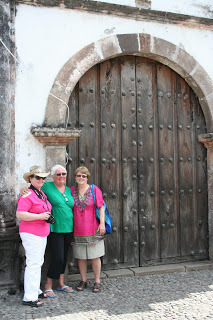 Some of the furniture that Hidalgo designed is on display.It's exquisite. Lovely wood (parota?) with painted inlays, birds and flowers,yellows and oranges and blues. Ornate carvings and interesting designs. We finda book inside a glass case that's signed to Alejandro – a friend of art and afriend of mine in Spanish – from Diego Rivera. He and Freda Kahlo were frequentvisitors and contemporaries of Hildalgo and his wife. Hidalgo donated thebuildings and the grounds to the University of Colima. He died not that manyyears ago.
Some of the furniture that Hidalgo designed is on display.It's exquisite. Lovely wood (parota?) with painted inlays, birds and flowers,yellows and oranges and blues. Ornate carvings and interesting designs. We finda book inside a glass case that's signed to Alejandro – a friend of art and afriend of mine in Spanish – from Diego Rivera. He and Freda Kahlo were frequentvisitors and contemporaries of Hildalgo and his wife. Hidalgo donated thebuildings and the grounds to the University of Colima. He died not that manyyears ago.
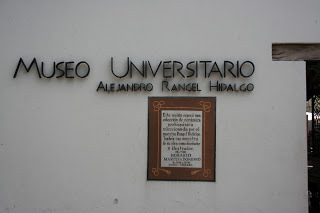 After the museum and studio, we visit the Eco Parque. It'simpossible to recount the number of trees, flowers and bushes that we enjoy,all with the sound of the waterfall and waterways that are constructed on thehillside. The pictures say it best. We sit for a while listening to the wind inthe bamboo making them click and groan, gasping at the beautiful yellowprimavera through green trees and blue sky.
After the museum and studio, we visit the Eco Parque. It'simpossible to recount the number of trees, flowers and bushes that we enjoy,all with the sound of the waterfall and waterways that are constructed on thehillside. The pictures say it best. We sit for a while listening to the wind inthe bamboo making them click and groan, gasping at the beautiful yellowprimavera through green trees and blue sky.
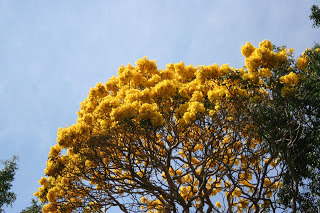
On the way back to Colima, we visit a coffee manufacturingbusiness. It's amazing to see the process and how much is done by hand. Wesample the delicious results. We are much closer to the volcanoes now and snapmore shots. Colima's own Magnetic Hill is next. José stops the van andwe walk it a bit, astounded. By sight, we're going uphill, but it's obviouslydownhill, both because we feel it as we walk and because the car keeps goingeven in neutral. Heading back to the city, I am struck by all the sights:clothes on hangers scattered over a barbed wire fence; plastic dolls in awindow, staring sightlessly through the wrought iron; a bull rests on someone'sfront lawn. A large house has an arch that announces, "Los Simpsons". Chickenspeck in several yards. José shows us a drive-thru beer store. The Sierras glint in the sun and whiteclouds. Sculpted trees and bushes decorate the dancing dogs squareand roadsides. One of them is a human form that looks as though it is sliding,arms raised, down the tree. It reminds me of the poem about sliding to the endof your life calling YIPEE all the way. Appropriately enough, when we return to the hotel, we arejust in time for a seniors' club parade. The dancers are all older and somevery elderly. There are people in wheelchairs. The costumes are astonishing,reds, blues, golds…every color and style imaginable. We dance on the balconiesand drink beer or margueritas. This activity makes for an early dinner and bed!We sleep with the sounds of the church, the people in the square, and trafficjust outside our windows.
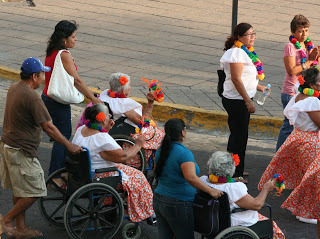
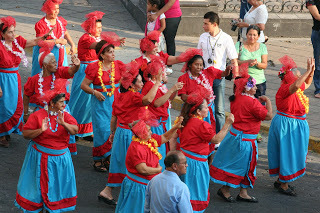
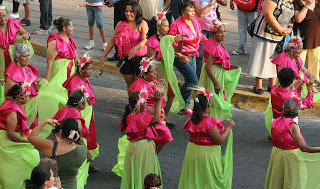
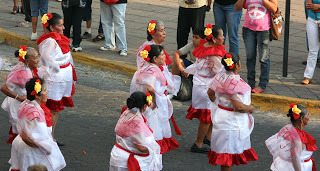
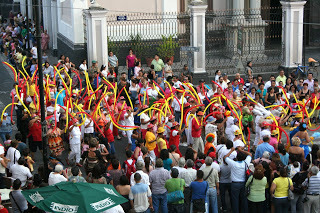
Published on February 24, 2012 06:29
No comments have been added yet.



